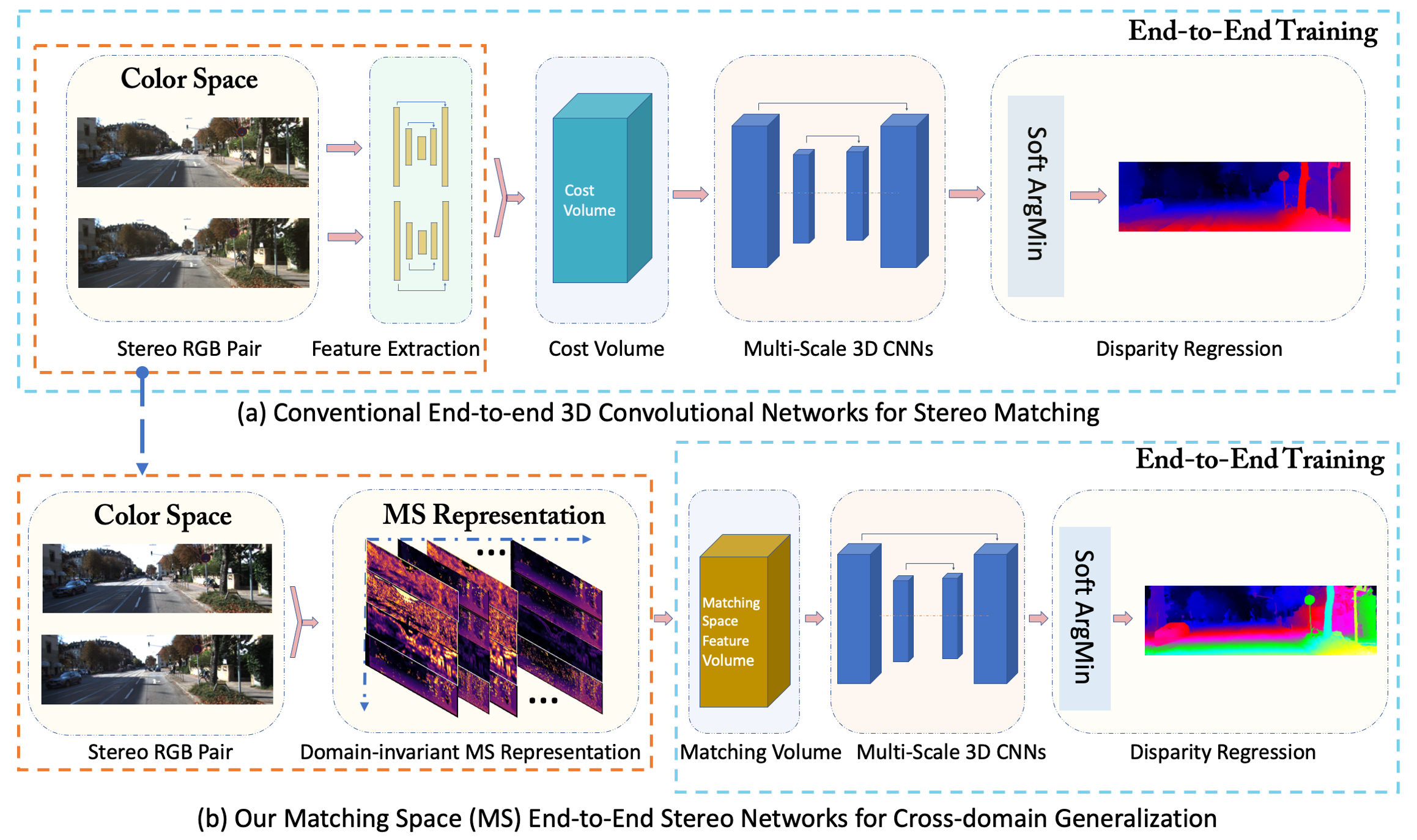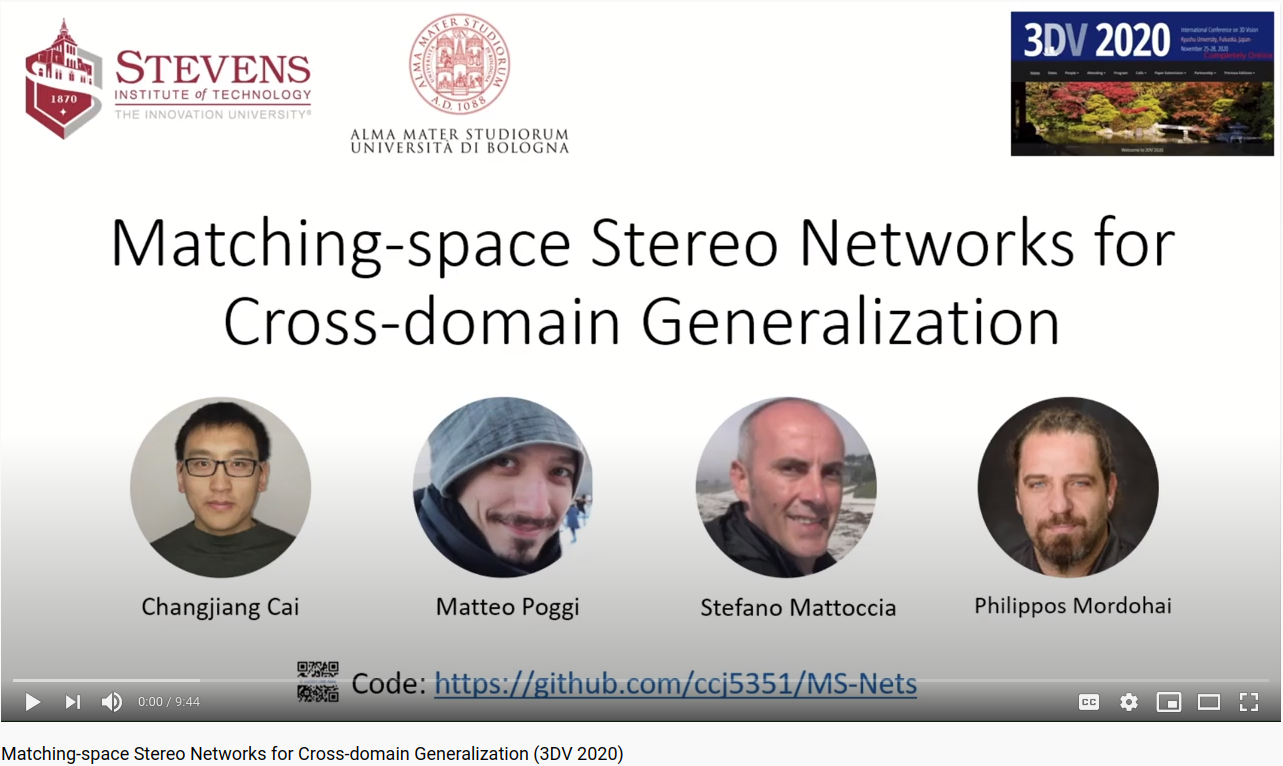This is a work by Changjiang Cai, Matteo Poggi, Stefano Mattoccia, Philippos Mordohai - 3DV 2020
See the links: arXiv, Slides, Poster, Conf-Proceeding
Please check our presentation video as shown below:
The repository contains the code, models and instructions for training and testing.
We propose our matching space stereo networks - MSNet, with improved generalization properties. First, we replace learning-based feature extraction from RGB with Matching functions and confidence measures from conventional wisdom. This way, we move the learning process from color space to Matching Space, avoiding over-specialization to domain specific features. Specifically, we modify GCNet and PSMNet architectures to accept Matching Space inputs. PSMNet allocates most of the parameters to unary feature extraction, while GCNet does this to 3D convolutions, resulting in different behaviors of domain generalization.
The following shows our setup succefully run in our experiments (N.B. older or later versions might work, but we do not test).
gcc: 7.5.0
GPU: Titan XP (12GB) or Titan RTX (24GB)
pytorch: >=1.2.0
cuda: >=10.0
OpenCV: opencv-3.2.0
Boost: 1.72.0 (for Boost Python)
Other commonly used Python Lib: e.g., Numpy, Matplotlib, Cython etc (Check the code for details)
Verified platform/settings: ubuntu 16.04 (or 18.04) + cuda 10.0 + python 3.7 (or 3.5)
Assuming this repository is located at ~/MS-Nets (definitely you can put it anywhere you prefer), with Ubuntu 18.04 OS and Python 3.7.
-
Compile the code to generate the libraries (with the help of Boost-Python) which are used to extract Matching Space (MS) features, as follows:
cd ~/MS-Nets/src/cpp # check the CMakeLists.txt for the details; mkdir build && cd build cmake .. && make
This will generate the libraries
libfeatextract.soandlibmatchers.so, which you can see at~/MS-Nets/src/cpp/libdirectory.NOTE: If you met some compiling error in this step, e.g.,
fatal error: numpy/ndarrayobject.h: No such file or directory. You can sepicify the include directory inCMakeList.txt:include_directories( {OpenCV_INCLUDE_DIRS} #You can choose one that works for you. #/usr/local/lib/python2.7/dist-packages/numpy/core/include #/usr/local/lib/python3.7/site-packages/numpy/core/include /usr/local/lib/python3.7/dist-packages/numpy/core/include )
-
(Optional) Compile the libraries which are used to generate KITTI-color-style disparity maps and disparity error maps, both of which are used by our PyTorch codes to generate summary images for Tensorboard visualization to monitor the network training.
cd ~/MS-Nets/src/cython # check the compile.sh file for the details; sh ./compile.sh
This will generate the libraries, e.g.,
writeKT15ErrorLogColor.cpython-37m-x86_64-linux-gnu.soandwriteKT15FalseColorcpython-37m-x86_64-linux-gnu.so(Please note that here*-37m-*means Python 3.7, and you might get different names depending on your system), located at~/MS-Nets/src/cythondirectory. -
Training, Evaluation and Testing:
- See the bash file
do_main_msnet.shfor more details. - Basically you can specify
TASK_TYPEvariable in the bash file for different tasks, including:TASK_TYPE='loop-train' or 'train'for network training,TASK_TYPE='val-30'for evaluation andTASK_TYPE='cross-val'for the cross domain generalization evalution.
- See the bash file
- Pytorch pretrained modles on Scene Flow Dataset: MS-GCNet and MS-PSMNet.
- NOTE: The original MS-GCNet model is implemented in Keras. So if you are intrested in this Keras model, please email me.
-
Please check more detailed resutls in
Table 1of our paper. Here we show generalization results for baseline GCNet and our MS-GCNet. The results are slightly better than the ones reported in our papaer (which were run by our original Keras model). -
Here SF means Scene Flow dataset, KT12 and KT15 mean KITTI 2012 and KITTI 2015, and MB for Middlebury 2014, and ETH3D for ETH3D Low-res two-view dataset.
| SF -> Others | KT12 (bad3-noc) | KT15 (bad3-all) | MB (bad3-noc) | ETH3D (bad1-noc) |
|---|---|---|---|---|
| GCNet | 6.22% | 14.68% | 30.42% | 8.03% |
| MS-GCNet(ours) | 4.97% | 6.26% | 27.46% | 8.28% |
- If you find the code useful, please cite our paper:
@inproceedings{cai2020matchingspace,
title={Matching-space Stereo Networks for Cross-domain Generalization},
author={Changjiang Cai and Matteo Poggi and Stefano Mattoccia and Philippos Mordohai},
booktitle={2020 International Conference on 3D Vision (3DV)},
year={2020},
pages={364-373},
doi={10.1109/3DV50981.2020.00046}
}
- Or the arXiv version.
@misc{cai2020matchingspace,
title={Matching-space Stereo Networks for Cross-domain Generalization},
author={Changjiang Cai and Matteo Poggi and Stefano Mattoccia and Philippos Mordohai},
year={2020},
eprint={2010.07347},
archivePrefix={arXiv},
primaryClass={cs.CV}
}
- For the matching space features, please cite this paper:
@inproceedings{batsos2018cbmv,
title={CBMV: A Coalesced Bidirectional Matching Volume for Disparity Estimation},
author={Batsos, Konstantinos and Cai, Changjiang and Mordohai, Philipos},
booktitle={IEEE Conference on Computer Vision and Pattern Recognition (CVPR)},
year={2018}
}
Changjiang Cai, Email: changjiangcai2020 AT Gmail or hit my homepage.
Part of the code is adopted from existing works of GCNet, PSMNet and so on. We thank the awesome repositories provided by the authors and/or the third party.

